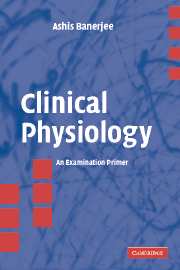2 - Water and Electrolyte Balance
Published online by Cambridge University Press: 05 June 2016
Summary
Water balance
In most steady state situations, water intake matches water losses through all sources. Water balance involves adjusting the effects of intake, which is determined by thirst; renal dilution or concentration of urine; and losses, via the skin, kidney, gastrointestinal tract, respiratory tract.
The usual sources of water intake are ingested liquids, foods (fruits and vegetables) and endogenous metabolic water production.
The sources of water output comprise:
Sensible losses: urine, stools and sweat. The ability to dilute and to concentrate urine allows for a wide flexibility in urine flow.
Insensible losses: skin loss (insensible perspiration); exhaled air from the respiratory tract.
Mechanisms of water homeostasis
The mechanisms contributing to water balance can be outlined as:
Afferent mechanisms, involving hypothalamic osmoreceptors; non-osmotic arginine vasopressin sensors, activated by pain, stress, vomiting and extracellular fluid changes; and thirst sensors.
Efferent mechanisms, including arginine vasopressin release, and increased thirst.
Osmolality and tonicity
The total solute concentration (tonicity) of body fluids is maintained virtually constant. Body fluid osmolality is defined by the ratio of total body solute to total body water. It is regulated at 280–95 mOsm/l. Osmolality is a colligative property, depending on the number of dissolved solute particles, and not on size or structure of the particles. The maintenance of osmolality is achieved primarily through the regulation of water balance.
Osmolality (in mOsm/l) = n x molar concentration (mmol/l of water) Plasma osmolality (in mOsm/kg) = 2(Na+)+(K+)+(glucose)+urea (all in mmol/l)
Osmolar gap = measured plasma osmolality - calculated plasma osmolality The osmolar gap is a measure of unmeasured osmotically active molecules, such as mannitol and alcohols.
Components of extracellular fluid
Extracellular fluid comprises:
Blood plasma.
Lymph.
Transcellular fluids: intra-ocular, pericardial, peritoneal, pleural and synovial fluids. These are separated from plasma by an additional epithelial layer.
Cerebrospinal fluid.
Glandular secretions.
Measurement of body fluid compartments
The volume of body fluid compartments is measured by the dilution of indicators, which must fulfil the following requirements:
All the indicator administered remains in the volume to be measured;
Uniform distribution of the indicator follows an adequate time for mixing;
The indicator does not alter the volume of the compartment;
The indicator does not enter the system by another route.
The volume of the compartment = (The amount of the indicator administered - the amount of indicator excreted)/Concentration of indicator in the volume being measured.
- Type
- Chapter
- Information
- Clinical PhysiologyAn Examination Primer, pp. 19 - 30Publisher: Cambridge University PressPrint publication year: 2005



